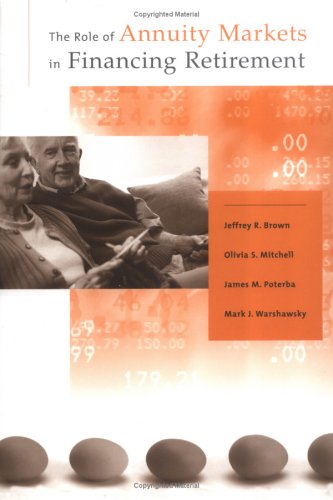MIT Press
3 total works
The Role of Annuity Markets in Financing Retirement
by Jeffrey R. Brown, etc., Olivia S. Mitchell, James M Poterba, and Mark J. Warshawsky
Published 9 November 2001
Dramatic advances in life expectancy mean that today's retirees must plan on living into their eighties, their nineties, and even beyond. Longer life expectancies are the symbol of a prosperous society, but this progress also means that some retirees will need to plan conservatively and cut back substantially on their living standards or risk living so long that they exhaust their resources. This book examines the role that life annuities can play in helping people protect themselves against such outcomes.A life annuity is an insurance product that pays out a periodic amount for as long as the annuitant is alive, in exchange for a premium. The book begins with a history of life annuity markets during the twentieth century in the United States and elsewhere. It then explores recent trends in annuity pricing and money's worth, as well as the economic value generated for purchasers of these products. The book explains the potential importance of inflation-protected annuities and stock-market-linked variable annuities in providing more complete retirement security.
The concluding chapters examine life annuities in various institutional settings and the tax treatment of annuity products.
The concluding chapters examine life annuities in various institutional settings and the tax treatment of annuity products.
Retirement, Pensions, and Social Security
by Gary S. Fields and Olivia S. Mitchell
Published 19 December 1984
This book places retirement in an economic context, calculating the income opportunities facing older workers at alternate retirement ages, and estimating how responsive retirement ages are to changes in income opportunities.
American workers are retiring earlier, living longer, and receiving greater retirement benefits for each year out of the labor force than ever before, which has created serious financial pressures on the nation's Social Security system and generated an intense and often heated debate. This book places retirement in an economic context, calculating the income opportunities facing older workers at alternate retirement ages, and estimating how responsive retirement ages are to changes in income opportunities. It is the first book length study to combine evidence on private pension and Social Security institutions with econometric evidence on the determinants of retirement behavior, providing new empirical results that shed light on current policy issues.Retirement, Pensions, and Social Security reveals the importance of earnings, private pensions, and Social Security benefits compared to health, mandatory retirement, and other noneconomic factors in determining retirement patterns; the amounts of private pension and Social Security benefits that workers would receive at alternate retirement ages; the prospective budget sets facing potential retirees from ages 60 to 68; and variation across pension plans in the gains or losses from deferring retirement. It describes regression models showing that retirement patterns can be explained in part by the retirement income streams available at age 60 and by the gain in retirement income if retirement is postponed to age 65, and multinomial logit and ordered logit models which formulate the retirement decision in a utility-based framework while accounting for unmeasured preferences of individuals and nonlinearities in income opportunities. The book predicts the responsiveness of retirement ages and retirement incomes to reductions in Social Security benefits, using several different prediction methods including a new one published here for the first time. And it explains the differences in average retirement ages among workers in different pension plans in terms of differences in the economic rewards for deferring retirement and differences in workers' taste for income and leisure.
American workers are retiring earlier, living longer, and receiving greater retirement benefits for each year out of the labor force than ever before, which has created serious financial pressures on the nation's Social Security system and generated an intense and often heated debate. This book places retirement in an economic context, calculating the income opportunities facing older workers at alternate retirement ages, and estimating how responsive retirement ages are to changes in income opportunities. It is the first book length study to combine evidence on private pension and Social Security institutions with econometric evidence on the determinants of retirement behavior, providing new empirical results that shed light on current policy issues.Retirement, Pensions, and Social Security reveals the importance of earnings, private pensions, and Social Security benefits compared to health, mandatory retirement, and other noneconomic factors in determining retirement patterns; the amounts of private pension and Social Security benefits that workers would receive at alternate retirement ages; the prospective budget sets facing potential retirees from ages 60 to 68; and variation across pension plans in the gains or losses from deferring retirement. It describes regression models showing that retirement patterns can be explained in part by the retirement income streams available at age 60 and by the gain in retirement income if retirement is postponed to age 65, and multinomial logit and ordered logit models which formulate the retirement decision in a utility-based framework while accounting for unmeasured preferences of individuals and nonlinearities in income opportunities. The book predicts the responsiveness of retirement ages and retirement incomes to reductions in Social Security benefits, using several different prediction methods including a new one published here for the first time. And it explains the differences in average retirement ages among workers in different pension plans in terms of differences in the economic rewards for deferring retirement and differences in workers' taste for income and leisure.
This book develops a consistent macroscopic theory of electromagnetism and discusses the relation between circuit theory and field theory. The theory is developed in successive steps from the Lorentz force, the integral form of Maxwell's equations in free space, and suitable macroscopic models of polarized and magnetized matter.Special features* Covers the electromagnetism of moving bodies and the process of electromechanical energy conversion* Introduces a power-series technique for analyzing quasi-static fields and quasi-stationary systems* Emphasizes the synthesis of fields as opposed to the analysis of fields* Presents, in an appendix, the four-dimensional relativistic formulation of macroscopic electrodynamics recently developed by one of the authors (L. J. Chu)


